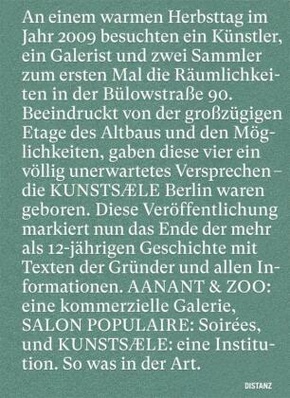
| Verlag | Distanz Verlag |
| Auflage | 2023 |
| Seiten | 928 |
| Format | 24,4 x 7,0 x 32,2 cm |
| Großformatiges Paperback. Klappenbroschur | |
| Gewicht | 4445 g |
| ISBN-10 | 3954764229 |
| ISBN-13 | 9783954764228 |
| Bestell-Nr | 95476422A |
Ein Stück Berliner Kunstgeschichte
Im Frühjahr 2010 starteten KUNSTSÆLE Berlin ihr Programm als Gemeinschaftsprojekt zweier Kunstsammler_innen, einem Künstler und einem Galeristen und pragten seitdem mit über 130 Ausstellungen die Kunstlandschaft in Berlin. In den Raumen in der Bülow- straße, in denen Samuel Fischer einst Franz Kafka verlegte, schufen die Macher_innen eine Plattform und ihre Legenden. Im letzten Jahr wurde die Institution aus eigenem Willen geschlossen.
Das umfangreiche Buch führt auf über 900 Seiten chronologisch durch die letzten zehn Jahre der Ausstellungsgeschichte, u. a. mit und über Andre Butzer, Lovis Corinth, Channa Horwitz, Friedrich Kunath, Michael Müller, Blinky Palermo, Manfred Pernice, James Rosenquist, Karin Sander, Thomas Scheibitz, Josef Strau, Elaine Sturtevant oder Peter Wachtler. Neben der Chronologie erzahlen Geraldine Michalke, Lukas Topfer und Ellen Blumenstein in Textbeitragen über den Ort, seine Diskurse und die Mensch en, die diese gepragt haben.
A Piece of Berlin Art History
KUNSTSÆLE Berlin was established in the spring of 2010 as a joint venture by two art collectors, an artist, and a gallery owner. Since then, they have put their stamp on the Berlin arts scene, programming more than 130 exhibitions in their rooms on Bülowstraße. Where, a century ago, Samuel Fischer published Franz Kafka's writings, the partners built a platform and created legends. Last year they decided to shut down the institution.
On over 900 pages, the thick tome lays out a chronological tour of ten years of exhibition-making, starring Andre Butzer, Lovis Corinth, Channa Horwitz, Friedrich Kunath, Michael Müller, Blinky Palermo, Manfred Pernice, James Rosenquist, Karin Sander, Thomas Scheibitz, Josef Strau, Elaine Sturtevant, Peter Wachtler, and many others. The chronology is complemented by contributions by Geraldine Michalke, Lukas Topfer and Ellen Blumenstein, who recall the venue, its discour ses, and the individuals who made it what it was.
